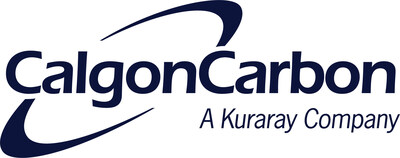Calgon Carbon Releases Second Peer-Reviewed Study Confirming PFAS Removal and Destruction with Custom Municipal Reactivation
Calgon Carbon Releases Second Peer-Reviewed Study Confirming PFAS Removal and Destruction with Custom Municipal Reactivation |
| [02-October-2025] |
Highlights: >99.9% PFAS Destruction Removal Efficiency. Achieved during full-scale thermal reactivation of spent drinking water carbon under Calgon Carbon's typical operating conditions using OTM-45's conservative calculation methodology. Removes PFAS from the Spent Carbon to Non-Detect Levels. The study confirms all tested PFAS compounds were removed to below detectable levels from the spent carbon through Calgon Carbon's proprietary custom municipal reactivation process. No Products of Incomplete Combustion (PICs) or Reformed PFAS Detected. State-of-the-art EPA test methods (OTM-50, and EPA Method 0010/8720 for fluorinated PIC's analysis) found no detectable PFAS PIC byproducts or reformed PFAS emissions throughout the reactivation process. Results Mirror Prior White Paper. New findings reinforce those of Calgon Carbon's first peer-reviewed PFAS study in 2022 for industrial reactivation while improving upon the scientific understanding of reactivation using state-of the art analytical methodology. Establishes a Clear Differentiator for Addressing "Forever Chemicals." Unlike other approaches that simply transfer PFAS into another waste stream for disposal or incineration, Calgon Carbon's reactivation technology provides an economical, verified pathway to recycle activated carbon for continued use. PITTSBURGH, Oct. 2, 2025 /PRNewswire/ -- Calgon Carbon Corporation ("Calgon Carbon"), a wholly owned subsidiary of Kuraray Co., Ltd. (TYO: 3405), announced the publication of its second peer-reviewed white paper on the reactivation of PFAS laden spent carbon, titled "Destruction of PFAS During Thermal Reactivation of Granular Activated Carbon Used in Potable Water Treatment," in the Remediation Journal. Building on our prior peer-reviewed work, this study not only reaffirms the proven performance of reactivation but uniquely validates the effectiveness of Calgon Carbon's proprietary full-scale drinking water reactivation process, commonly referred to as custom municipal reactivation. Through high-temperature reactivation, municipalities and industrial users can recycle spent activated carbon while removing the PFAS contaminants below detectable limits from the carbon with a destruction removal efficiency of > 99.9%. Unlike other PFAS treatment approaches, reactivation returns carbon to service, expands supply availability, and lowers CO₂ emissions compared to virgin activated carbon production, a solution that reduces waste and supports sustainability goals. "This publication once again highlights Calgon Carbon's leadership in water treatment innovation and our unwavering commitment to combatting PFAS pollution," said Steve Schott, President and CEO of Calgon Carbon Corporation. "By investing in research and validating our solutions through peer-reviewed science, we continue to deliver the confidence our customers and communities need to tackle these contaminants head-on." The study's findings come at a pivotal moment as municipalities nationwide are testing for PFAS and preparing treatment plans to meet the U.S. EPA's new Maximum Contaminant Levels (MCLs). These results provide utilities with independent validation that reactivation is a proven, scalable path forward at a time when compliance is both urgent and unavoidable. "The data detailed in our article effectively demonstrated the removal of PFAS compounds from granular activated carbon (GAC) and greater than 99.9% destruction removal efficiency for PFAS compounds through the furnace and off-gas abatement system. Expanding on the results from the prior publication, the study yielded non-detect results for products of incomplete combustion and reformed PFAS using state-of-the-art test methods. Importantly, this study addresses the U.S. EPA's desire for additional data around the potential formation of these byproducts during reactivation," said Dr. Elisa Mayerberger, lead author of the Remediation article and Applications Engineer at Calgon Carbon. GAC is the most widely used and well-established technology for the treatment and removal of PFAS contaminants from drinking water and wastewater. Calgon Carbon's FILTRASORB® GAC, sourced from bituminous coal, has demonstrated superior PFAS-removal capabilities compared to other carbons for over two decades. Thermally treating GAC at the end of its initial service life — known as spent carbon — is called reactivation, a process that desorbs and destroys adsorbed contaminants at extremely high temperatures and restores the GAC to a near-virgin state so it can be reused for multiple cycles with the same results. In the first stage of Calgon Carbon's proprietary reactivation process, PFAS-laden GAC is heated in a furnace for several hours at high temperatures, imparting enough energy to break down PFAS's carbon-fluoride bonds, the strongest in chemistry. The off gas from the reactivation furnace then moves into an abatement system, which features a thermal oxidizer/afterburner designed to destroy any organics that were not destroyed in the furnace. From there, it proceeds through a scrubber to neutralize any acid gases, such as hydrogen fluoride, and removes them from the abatement air. Finally, it passes through a baghouse to eliminate particulate matter. The result is a closed-loop, cost-effective solution that not only addresses a public health problem but also eliminates long-term PFAS waste from entering landfills. Calgon Carbon currently operates the world's largest network of GAC reactivation facilities, including six reactivation plants across the U.S., with additional facilities in Europe and Asia. This global infrastructure ensures that our customers can manage PFAS-laden carbon in a way that significantly reduces landfill usage and generates less greenhouse gas emissions as compared to virgin activated carbon replacement. "PFAS are often called 'forever chemicals,' but our superior performing FILTRASORB products effectively remove these PFAS compounds from water to non-detectable levels and, when coupled with our advanced reactivation process, destroy them to near non-detect levels," said Jenalle Brewer, Drinking Water Solutions, Innovative Carbon Technologies and Global Strategy & Communications. "For more than two decades, Calgon Carbon has been at the forefront of PFAS remediation, and this second peer-reviewed study provides further validation of our technical leadership. We will continue to invest in our people, products, and services to help municipalities in their mission to treat drinking water with effective, science-based solutions." The new white paper "Treatment of PFAS During Thermal Reactivation of GAC Used in Potable Water Treatment" is published in the Fall 2025 issue of Remediation Journal and is available via open access. Water treatment professionals and stakeholders are encouraged to review these findings to better understand how Calgon Carbon's technology is effectively removing PFAS to non-detectable levels and enabling the effective recycling of reactivated carbon in drinking water treatment. To learn more about Calgon Carbon's study and the FILTRASORB product, visit NoMorePFAS.com. About Calgon Carbon
SOURCE Calgon Carbon | ||
Company Codes: Tokyo:3405 |




















